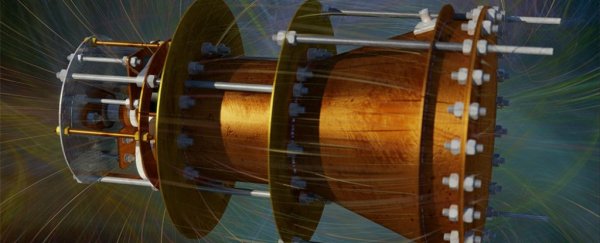Physicists have just published a new paper that suggests the controversial EM drive - or electromagnetic drive - could actually work, and doesn't defy Newton's third law after all.
In case you've missed the hype, here's a quick catch-up: a lot of space lovers are freaking out about the EM drive because of claims it could get humans to Mars in just 10 weeks, but just as many are sick of hearing about it, because, on paper at least, it doesn't work within the laws of physics.
Despite that not-insignificant setback, the EM drive shows no signs of quitting, and test after test - including trials by NASA scientists at the Eagleworks lab, and an independent researcher in Germany - has conceded that the propulsion system, somehow, does produce thrust.
Why is that so surprising? That's because of how the EM drive is supposed to work, in theory at least. First designed by British scientist Roger Shawyer back in 1999, the EM drive uses electromagnetic waves as fuel, and creates thrust by bouncing those microwaves back and forth within a metal cavity to trigger motion.
According to Shawyer's calculations, that could produce enough thrust to blast humans to Mars in just 70 days, and potentially even help us reach the next star system, Alpha Centauri, in just 92 years, all without the need for heavy, expensive rocket fuel.
That sounds pretty incredible, right? But there's one big problem - according to Newton's third law, everything must have an equal and opposite reaction, which means that something needs to be pushed out the back of propulsion system for it to move forwards. And, you pretty quickly see the dilemma - the EM drive doesn't use any fuel propellants, and so it doesn't have an exhaust, and so… it can't produce thrust. Even though it does.
Now that we've taken that round-trip right back to the dilemma we started with, let's present you with a potential solution, from physicists at the COMSOL company, the University of Helsinki, and the University of Jyväskylä in Finland.
According to their new peer-reviewed study published in AIP Advances, the EM drive doesn't actually defy Newton's third law, because it does produce exhaust.
*Cue scream face emoji*
According to the researchers, the exhaust being blasted out is actually light, or more specifically, photons that have become paired up with another out-of-phase photon in order to shoot out of the metal cavity and produce thrust.
So if that's the case, why hasn't anyone detected it before?
The researchers predict that's because photons need to become paired up in order to escape the fuel cavity, so that the two photons in those pairs are out of phase, which means they completely cancel each other out and have no net electromagnetic field. If you think of it like waves of water, if the crest of one wave occurs at the exact same time as the trough of another, they'll cancel each other out and produce a flat patch of water - despite the fact that two waves are still passing through it.
That's what's happening with the photons, so, in other words, the exhaust photons become invisible from an electromagnetic point of view because they're being masked by their out-of-sync partner.
"The EM drive operates by the same principle, for example, as a jet engine, where the high speed exhaust gases backwards (opposite reaction) push the airplane forwards," one of the researchers Arto Annila, told ScienceAlert over email.
"Light at microwave lengths is the fuel that's being fed into the cavity … and the EM drive exhausts backwards paired photons," he says. "When two photons travel together, but having opposite phases, then the pair has no net electromagnetic field, and hence it will not reflect back from the metal walls, but goes through."
And those escaping photons are the equal and opposite reaction that's producing the EM drive's thrust.
To be clear, this is just a hypothesis based on theoretical calculations. But it's not the first time photons have been used to propel spacecraft forward - it's also the idea that Bill Nye's solar sail is based on.
Annila is now hoping that engineers will take on the challenge of testing for these exhaust photon pairs in order to test whether their hypothesis holds up.
And that's going to be a challenge in itself, because without an electromagnetic signature, researchers are going to have to detect them by looking for "excess energy density above the surrounding background density of the gravitational field," Annila explained. That requires a device called an interferometer - not dissimilar to the ones that detect gravitational waves.
But if scientists can verify that these paired photons really are being pushed out the back, sh*t's going to get real for EM drives, because it'll help engineers design better cavities and produce even more thrust.
"If our proposal is found worthy then EM drive research is no longer questioned but propelled," said Annila.
But as exciting as that is, for Annila the space travel aspect is less interesting than the fundamental physics behind the controversial propulsion system.
"In history often curious phenomena and perplexing observations have opened up a whole new paradigm," he says. Maybe this time, it'll open up a whole new pathway to the Universe. Watch this space.
